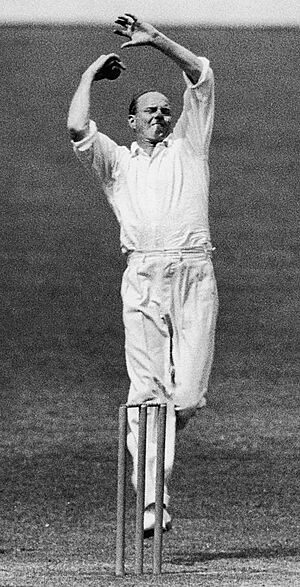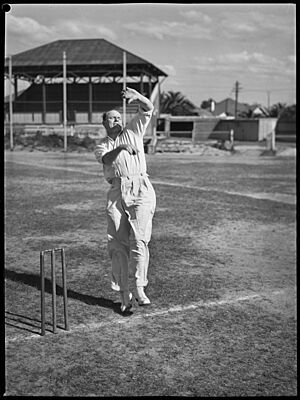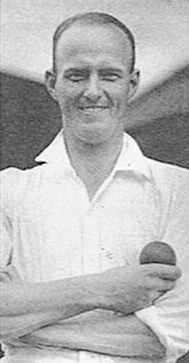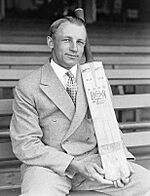Bill O'Reilly (cricketer) facts for kids
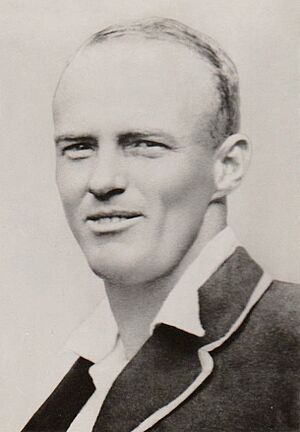
O'Reilly in the 1930s
|
||||||||||||||||||||||||||||||||||||||||
| Personal information | ||||||||||||||||||||||||||||||||||||||||
|---|---|---|---|---|---|---|---|---|---|---|---|---|---|---|---|---|---|---|---|---|---|---|---|---|---|---|---|---|---|---|---|---|---|---|---|---|---|---|---|---|
| Full name |
William Joseph O'Reilly
|
|||||||||||||||||||||||||||||||||||||||
| Born | 20 December 1905 White Cliffs, New South Wales, Australia |
|||||||||||||||||||||||||||||||||||||||
| Died | 6 October 1992 (aged 86) Sutherland, New South Wales, Australia |
|||||||||||||||||||||||||||||||||||||||
| Nickname | Tiger | |||||||||||||||||||||||||||||||||||||||
| Height | 6 ft 2 in (1.88 m) | |||||||||||||||||||||||||||||||||||||||
| Batting | Left-handed | |||||||||||||||||||||||||||||||||||||||
| Bowling | Right-arm leg break | |||||||||||||||||||||||||||||||||||||||
| Role | Bowler | |||||||||||||||||||||||||||||||||||||||
| International information | ||||||||||||||||||||||||||||||||||||||||
| National side | ||||||||||||||||||||||||||||||||||||||||
| Test debut (cap 140) | 29 January 1932 v South Africa | |||||||||||||||||||||||||||||||||||||||
| Last Test | 29 March 1946 v New Zealand | |||||||||||||||||||||||||||||||||||||||
| Domestic team information | ||||||||||||||||||||||||||||||||||||||||
| Years | Team | |||||||||||||||||||||||||||||||||||||||
| 1927/28–1945/46 | New South Wales | |||||||||||||||||||||||||||||||||||||||
| Career statistics | ||||||||||||||||||||||||||||||||||||||||
|
||||||||||||||||||||||||||||||||||||||||
|
Source: CricketArchive, 19 August 2007
|
||||||||||||||||||||||||||||||||||||||||
William Joseph O'Reilly OBE (born December 20, 1905 – died October 6, 1992) was an Australian cricket player. Many people consider him one of the greatest bowlers in the history of the game. After he stopped playing, he became a respected cricket writer and commentator.
O'Reilly was known as one of the best spin bowlers ever. He bowled the ball with two fingers at a medium speed, and he was very accurate. He could bowl leg breaks, googlies (balls that spin the opposite way), and top spinners. He did all this without changing how he moved his arm, which made it very hard for batsmen to guess what he would do. He was tall for a spinner, about 6 feet 2 inches (188 cm). He swung his arms a lot and released the ball from a low point. This made it difficult for batsmen to see the ball's flight.
When O'Reilly passed away, Sir Donald Bradman, a legendary cricketer, said O'Reilly was the greatest bowler he had ever faced or watched. In 1935, Wisden, a famous cricket publication, called him a "hostile" bowler. This meant he was very aggressive and tough to play against. In 1939, Wisden said he was "one of the greatest bowlers of all time."
As a batsman, O'Reilly was decent, usually batting lower down the team's order. Wisden noted that he could hit the ball very hard. He was always a threat to tired bowlers. O'Reilly was also known for being very competitive. He bowled with the same energy as a paceman. An English cricketer, Ian Peebles, wrote that O'Reilly would demand the ball back quickly after any scoring shot. He rarely offered a congratulatory word. This is why he earned the nickname 'Tiger'.
Contents
Early Life and Cricket Beginnings
Bill O'Reilly came from an Irish family. His grandfather moved to Australia from Ireland in 1865. Bill's father, Ernest, was a school teacher. The family moved often because of his father's job. Bill was born in White Cliffs, New South Wales, a town known for opal mining. He was the fourth of six children.
O'Reilly mostly taught himself how to play cricket. His family moved a lot, so he didn't have many chances for coaching. He played with his brothers using a "gum-wood bat and a piece of banksia root" as a ball. He learned to bowl because his older brothers always wanted to bat. His bowling style was unusual. Wisden said that when he first played in a junior match, his style made everyone laugh. But he quickly got out the other team. From a young age, O'Reilly was tall and lanky.
In 1917, when Bill was 12, his family moved to Wingello. This town loved cricket. O'Reilly started to really love the game there. He played for the town's team. He also won regional tennis championships. People said his bowling action looked like a windmill. He had to travel 50 km by train to Goulburn for high school. The train rides were long and cold, especially in winter.
In the early 1920s, Bill's oldest brother, Jack, moved to Sydney. Jack watched a famous spin bowler named Arthur Mailey practice. Jack wrote to Bill, describing how Mailey bowled a 'Bosie' (a type of spin ball). O'Reilly said he learned to bowl the bosie perfectly in just a few days. He practiced it every day. He called it his "most prized possession."
In 1921, O'Reilly became a boarder at St Patrick's College, Goulburn. He was very athletic there. He played rugby league, tennis, athletics, and cricket. He even set a state record in the triple jump. He also played for the town's cricket team. At St Patrick's, he developed his tough and careful approach to bowling.
Moving to Sydney and Meeting Bradman
After college, O'Reilly got a scholarship to Sydney Teachers College. He didn't enjoy it much. He felt it was too much theory and not enough practical training. He took a job helping at another college instead of attending lectures.
His first teaching job was in Erskineville, a poor area in Sydney. He found the students challenging but learned a lot about discipline. He also started a military cadet program there, and his students won a state competition.
During a holiday, O'Reilly stopped in Bowral to play cricket with his Wingello team. This is where he first met 17-year-old Don Bradman. O'Reilly later wrote about this meeting. He said he didn't know he was about to play against the greatest cricketer ever. Bradman scored 234 not out in that game. A week later, when the match continued, O'Reilly bowled Bradman out on the first ball. He said, "Suddenly cricket was the best game in the whole wide world." This was the start of a long relationship between the two cricket legends.
O'Reilly joined North Sydney Cricket Club in 1926–27. He was soon asked to play in a special match at the Sydney Cricket Ground. His school job made it hard to get time off, but he was ordered to play. He took six wickets in that match, but it was rained out. He was upset when his pay was cut for missing school.
First-Class Cricket Career
Early Matches
O'Reilly was chosen for the New South Wales practice squad in 1927–28. This was after he bowled out a state selector in a club game. He made his first-class debut that season. He played three matches and took seven wickets. In his first game against New Zealand, he took 2 wickets for 37 runs.
In 1928, O'Reilly was moved to Griffith, New South Wales, an outback town, for his teaching job. This meant he couldn't play first-class cricket for three years. He moved to other country towns, teaching and playing in local matches. He used this time to improve his "bosie" delivery. He felt this time away from coaches helped him develop his unique style.
Return to Top-Level Cricket
In late 1930, O'Reilly moved back to Sydney. He started playing for North Sydney again. He felt much stronger as a bowler. In the 1931–32 season, he became a key player for New South Wales. He was then chosen for the Australian cricket team for the Fourth Test against South Africa.
O'Reilly took four wickets in his Test debut at the Adelaide Oval. He supported the main leg-spinner, Clarrie Grimmett, who took 14 wickets. Australia won the match. O'Reilly kept his spot for the final Test in Melbourne. On a pitch made difficult by rain, he took three wickets as South Africa was bowled out for just 45 runs. He finished his first Test series with seven wickets. In Sheffield Shield cricket that season, O'Reilly took 25 wickets. New South Wales won the title. The next year, he took 31 wickets, and New South Wales won again.
Becoming a Test Star
O'Reilly became a regular player for Australia in the 1932–33 season. He played in all five Tests against England in the famous Bodyline series. Australian selectors thought O'Reilly would be their most important bowler. They kept him out of early matches so the English team couldn't figure out his bowling style.
In the first Test, O'Reilly took 3 wickets for 117 runs. He bowled many overs and was very economical, meaning he gave away few runs. In the Second Test in Melbourne, O'Reilly opened the bowling. He took 5 wickets for 63 runs, helping Australia get a lead. He then took another 5 wickets for 66 runs in the second innings, helping Australia win. This was his first time taking ten wickets in a Test match.
The English team used a controversial "fast leg theory" bowling style, which was very aggressive. Australia struggled against it. O'Reilly often had to open the bowling because Australia didn't have many fast bowlers. He took many wickets in the series, but Australia lost the series.
In the 1933–34 season, O'Reilly was the top bowler in the Sheffield Shield. He took 33 wickets. In one match against Victoria, he took 9 wickets for 50 runs in one innings. This included six Test players.
O'Reilly was chosen for the tour of England in 1934. He and Grimmett were the main bowlers. Australia won back the Ashes. In the First Test, O'Reilly took 11 wickets for 129 runs. His 7 wickets for 54 runs in the second innings was his best Test performance.
In the Third Test, O'Reilly took three wickets in four balls, including two of England's best batsmen, Cyril Walters and Wally Hammond. He ended that innings with 7 wickets for 189 runs. A draw in the Fourth Test led to a deciding match. Australia won that match by a huge margin, regaining The Ashes. O'Reilly was the top Australian bowler of the tour, taking 28 Test wickets. He was named one of the Wisden Cricketers of the Year in 1935.
O'Reilly played less state cricket in 1934–35 because his first child was born. He then toured South Africa in 1935–36. He was the vice-captain. O'Reilly took 27 Test wickets. He also showed his batting skills, scoring an undefeated 56 runs in one match. This was his highest score in first-class cricket.
Later Career and Retirement
When Don Bradman became captain after the South African tour, Clarrie Grimmett was dropped from the team. This left O'Reilly as the main bowler for Australia in the 1936–37 Ashes series. O'Reilly was upset about Grimmett being dropped. He believed it weakened the team.
O'Reilly became the top Australian wicket-taker in the series, with 25 wickets. He took five wickets in an innings once. Australia lost the first two Tests but then won the next three to keep The Ashes. O'Reilly's bowling was key in the final match.
In the 1937–38 season, O'Reilly played more state cricket. New South Wales won the Sheffield Shield. He took 33 wickets. In one match, he took nine wickets in the first innings and five in the second.
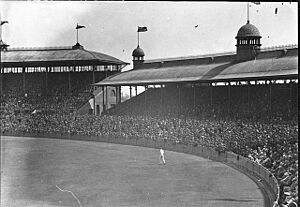
O'Reilly's last Ashes tour to England was in 1938. He was again the most effective bowler. He took 22 wickets in four Tests. Wisden noted that he bowled "consistently well and so effectively" even with little support.
In the Second Test, O'Reilly took 4 wickets for 93 runs. He also scored 42 runs, helping Australia avoid being forced to bat again. His greatest success was in the Fourth Test. On a difficult pitch, he took five wickets in each innings. This helped Australia win and keep the Ashes. O'Reilly said this was one of his best performances.
In the final Test, England scored a record 903 runs. O'Reilly took 3 wickets for 178 runs. He was the only Australian bowler to take more than one wicket. He said Len Hutton's score of 364 in that match was the best innings played against him.
O'Reilly played less state cricket in 1938–39 to spend time with his newborn son. He still took 10 wickets in one match against Victoria. He played regularly again in 1939–40, taking 55 wickets. First-class cricket stopped after one match in 1941–42 because of World War II. O'Reilly tried to join the military but was not allowed because his job was considered essential.
First-class cricket started again in 1945–46. O'Reilly, at 40, captained New South Wales. He took 33 wickets and his team was undefeated.
O'Reilly's final first-class cricket was a tour to New Zealand in early 1946. He was the team's vice-captain. The main match was against New Zealand, which was later called the first Test between the two countries. New Zealand was easily beaten. O'Reilly took 5 wickets for 14 runs in the first innings and 3 for 19 in the second. This was his last Test and first-class game. He retired after the match.
Relationship with Don Bradman
Even though Bradman and O'Reilly respected each other's cricket skills, their personal relationship was difficult. Bradman was a very private person who didn't drink or socialize much with teammates. This made some people feel he was distant. O'Reilly was known for being outspoken.
After O'Reilly stopped playing, he became a journalist. He often wrote critically about Bradman. It was said that O'Reilly and another journalist, Jack Fingleton, laughed when Bradman was bowled out for zero runs in his final Test innings. However, O'Reilly usually kept his strongest feelings about Bradman private. He once said, "You don't piss on statues," meaning he wouldn't openly disrespect a legend.
Despite their disagreements, O'Reilly wrote before his death that other batsmen were "child's play" compared to Bradman.
Life After Cricket
In 1933, O'Reilly married Mary Agnes "Molly" Herbert. They had two children. O'Reilly continued teaching after becoming an international cricketer. But in 1934, he resigned from his government teaching job because he was away so often for cricket. He then worked as a sports goods salesman.
In 1935, O'Reilly took a job at Sydney Grammar School, a private school. He taught English, history, and business. He was given 50% paid leave for his cricket. In 1939, he worked in a sports store owned by his friend and teammate, Stan McCabe. When World War II started, sales dropped, and O'Reilly left.
He then became a manager at the Lion Tile Company. He stayed there until 1976. He handled the company's finances and accounting. He was highly respected and was given full paid leave when he traveled overseas as a journalist.
In the late 1930s, O'Reilly helped mentor young cricketers Arthur Morris and Ray Lindwall. He encouraged Morris to become an opening batsman and Lindwall to be a fast bowler. Both went on to have long Test careers and are considered Australian greats. They both said O'Reilly was a major influence on them.
In 1956–57, McCabe and O'Reilly had a special match held in their honor. It raised a lot of money for them.
After retiring as a player, O'Reilly became a cricket writer for The Sydney Morning Herald. He wrote for them until 1988. He also wrote for a London newspaper, covering several Ashes series. His articles were known for being strong, witty, and honest. He hated one-day cricket, calling it "hit and giggle." He was a strong critic of changes in cricket, like the creation of coaches and the commercial side of the sport.
O'Reilly wrote two books about cricket tours. He believed in always telling his readers his true opinions. He said he never tried to say "the nice thing" or hide his thoughts.
O'Reilly received several awards later in his life. In 1980, he was given an Order of the British Empire for his contributions to cricket. In 1985, the oval in Wingello was named after him. In 1988, a grandstand at the SCG was named the Bill O'Reilly Stand. He was also named among the 200 people who contributed the most to Australia.
O'Reilly had poor health in his later years, including losing a leg. He died in 1992, just before his 87th birthday. He was sad about the decline of spin bowling in his last years. He died just months before Shane Warne brought leg spin back to international cricket.
In 1996, O'Reilly was added to the Australian Cricket Hall of Fame. In 2000, he was named in the Australian Cricket Board Team of the Century. In 2009, he was one of the first 55 people inducted into the International Cricket Council's Hall of Fame.
Cricket Statistics
In his 18-season first-class career, O'Reilly took 774 wickets at an average of 16.60 runs per wicket. In his 27 Test matches, he took 144 wickets at 22.59 runs per wicket. Of these, 102 wickets were in his 19 Ashes Tests against England.
Test Match Performance Summary
| Batting | Bowling | ||||||||
|---|---|---|---|---|---|---|---|---|---|
| Opponent | Matches | Runs | Average | High Score | 100s / 50s | Runs | Wickets | Average | Best (Innings) |
| 19 | 277 | 10.65 | 42 | 0/0 | 2,587 | 102 | 25.36 | 7/54 | |
| 1 | – | – | – | – | 33 | 8 | 4.12 | 5/14 | |
| 7 | 133 | 22.16 | 56* | 0/1 | 634 | 34 | 18.64 | 5/20 | |
| Overall | 27 | 410 | 12.81 | 56* | 0/1 | 3,254 | 144 | 22.59 | 7/54 |
Career Rankings
The International Cricket Council's LG Ratings have calculated that O'Reilly was the best bowler in the world for much of his career.
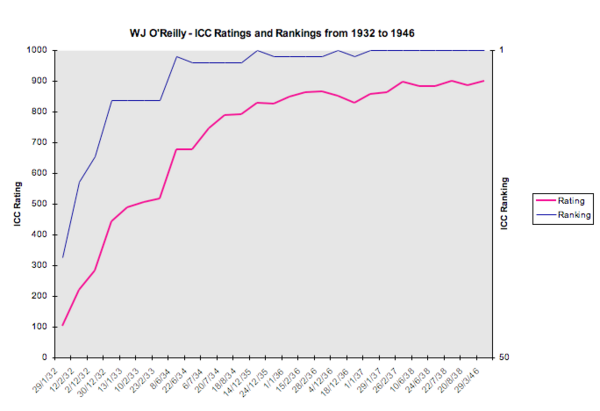
Song Tribute
Folk musician Ted Egan released a song called "The Tiger and the Don." It was about O'Reilly and Don Bradman. The song was on his 2003 album The Land Downunder.
|


